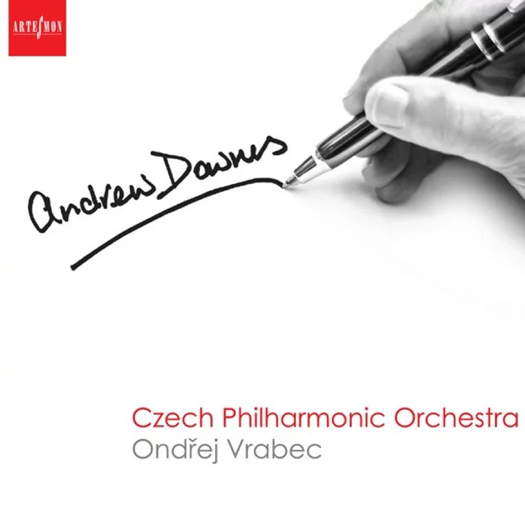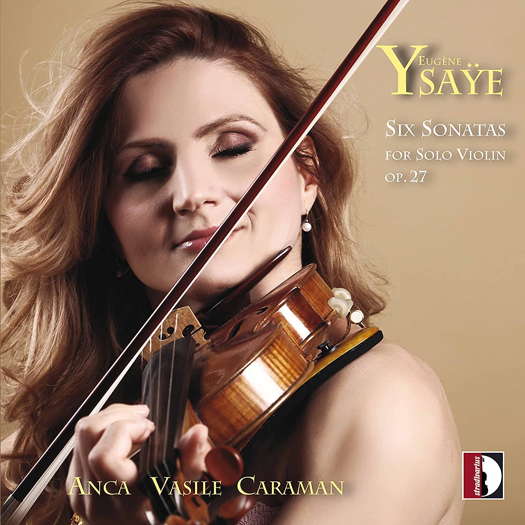 SPONSORED: CD Spotlight. On Buoyant Form - Orchestral music by Andrew Downes, heard by Roderic Dunnett.
SPONSORED: CD Spotlight. On Buoyant Form - Orchestral music by Andrew Downes, heard by Roderic Dunnett.
All sponsored features >>

A Fresh Rendering
GIUSEPPE PENNISI listens to solo violin sonatas by Eugène Ysaÿe, played by Anca Vasile Caraman
'This is a sophisticated CD with emphasis on the variety of tones of expression.'
Anca Vasile Caraman is a well-known Romanian violinist. She began to study violin at the age of four. She attended the George Enescu Music High School and the National Music University in Bucharest as well as the advanced specialization course in violin at the National Santa Cecilia Academy in Rome. She taught for a few years at the Brescia Conservatory. Now she is engaged full time in performances, not only in Romania and Italy, but all over the world - France, Germany, Switzerland, China, Japan, Sweden, Denmark, the Netherlands, Belgium and England. She has already a good discography.
Her latest CD is entirely dedicated to Eugène-Auguste Ysaÿe (1858-1931), a Belgian virtuoso violinist, composer and conductor who was regarded as 'The King of the Violin' or, as Nathan Milstein put it, the 'Tsar'. As a player, he was known for his elegance, a full tone with a sense of drawing a 'long' bow with no jerks, and precise left hand techniques. He bowed using the whole forearm while keeping both the wrist and upper arm quiet (as opposed to Joseph Joachim's German school of wrist bowing and Leopold Auer's Russian concept of using the whole arm). As his physical ailments due to diabetes grew more prohibitive, Ysaÿe turned more to teaching, conducting and an early love, composition. Among his most famous works are the six Sonatas for Solo Violin Op 27 as featured on this CD. Ysaÿe had been offered the post of music director of the New York Philharmonic in 1898, but declined it due to his busy solo performance schedule. In 1918, he accepted the music director's position with the Cincinnati Symphony Orchestra, where he remained until 1922 and with which he made several recordings.
After having heard Joseph Szigeti perform Johann Sebastian Bach's Sonata for solo violin in G minor, Ysaÿe was inspired to compose violin works that represented the evolution of musical techniques and expressions of his time. As Ysaÿe claimed, 'I have played everything from Bach to Debussy, for real art should be international'. In this set of sonatas, he used prominent characteristics of early twentieth century music, such as whole tone scales, dissonances, and quarter tones. Ysaÿe also employed virtuoso bow and left hand techniques throughout, for he believed that 'at the present day the tools of violin mastery, of expression, technique, mechanism, are far more necessary than in days gone by. In fact they are indispensable, if the spirit is to express itself without restraint.'
The six sonatas for solo violin are each dedicated to a different famous violinist and written in their corresponding styles:
- Sonata No 1 - Joseph Szigeti
- Sonata No 2 - Jacques Thibaud
- Sonata No 3 - Georges Enescu
- Sonata No 4 - Fritz Kreisler
- Sonata No 5 - Mathieu Crickboom
- Sonata No 6 - Manuel Quiroga
In this set of sonatas, Ysaÿe used prominent characteristics of early twentieth century music, such as whole tone scales, dissonances, and quarter tones. He also employed virtuoso bow and left hand techniques throughout. Thus, this set of sonatas places high technical demands on its performers. Yet Ysaÿe recurrently warns violinists that they should never forget to play instead of becoming preoccupied with technical elements; a violin master 'must be a violinist, a thinker, a poet, a human being, he must have known hope, love, passion and despair, he must have run the gamut of the emotions in order to express them all in his playing'.
The six sonatas are Ysaÿe's most often recorded work. Since 1975 to 2021, there are at least fifty CDs. Nonetheless, Anca Vasile Caraman's recording is a good addition that deserves to be listened to. In her fresh rendering, the sonatas can be clearly divided into three different groups. The first and the fourth refer to baroque models as can been seen by the choice of the movements' titles, eg Fugato and Sarabanda.
Listen — Ysaÿe: Fugato (Sonata for solo violin in G minor, Op 27 No 1)
(STR 37200 track 2, 0:02-0:57) ℗ 2021 Stradivarius :
The second pair are the second and the fifth with programmatic indications - Obsession and Danse rustique - which are a feature of twentieth century musical style.
Listen — Ysaÿe: Danse rustique (Sonata for solo violin in G, Op 27 No 5)
(STR 37200 track 14, 1:30-2:28) ℗ 2021 Stradivarius :
The third and the sixth are unusually short sonatas of only one movement each.
Listen — Ysaÿe: Ballade (Sonata for solo violin in D minor, Op 27 No 3)
(STR 37200 track 9, 0:00-6:53) ℗ 2021 Stradivarius :
Consequently, Anca Vasile Caraman's virtuoso playing shows quite well that the six sonatas are not only a tribute to six composers but also to two centuries of violin tradition. She emphasizes Bach's quotations, romantic echoes, harmonies borrowed from Debussy and rhythmic sequences from Bartók.
This is a sophisticated CD with emphasis on the variety of tones of expression. It is an excellent addition to the large number of recordings of Ysaÿe's six sonatas.
Copyright © 8 June 2022
Giuseppe Pennisi,
Rome, Italy

CD INFORMATION - YSAŸE: SIX SONATAS - ANCA VASILE CARAMAN



